Degradation-Sensitive Health Indicator Construction for Precise Insulation Degradation Monitoring of Electromagnetic Coils
Abstract
:1. Introduction
2. Insulation Degradation Monitoring Method of Electromagnetic Coils
2.1. Collection of High-Frequency Electrical Response Parameters
2.2. Construction of Preliminary Health Indicators
2.3. Determination of DSHI
2.4. Insulation Degradation Monitoring Based on DSHI
3. Experimental Setup and Result Analysis
3.1. Winding Accelerated Test and Its High-Frequency Response Measurement and Analysis
3.1.1. Winding Accelerated Test and Its High-Frequency Response Measurement
3.1.2. Experiment Results Analysis of the DSHI-Based Method
3.1.3. Experiment Results Analysis of the Existing Methods
3.2. Twisted Pair Accelerated Test and Obtainment of Actual Turn Insulation Status
- Utilizing Catiav5R21, construct the geometric model of the transformer with consideration of its symmetry in the xyz direction. Only one-eighth of the transformer without symmetry is reserved for actual simulation to reduce unnecessary calculations. The geometric model should consist of the core, the core skeleton, the primary and secondary coils, as well as the insulation paper between them.
- Import the Catia 3D model into the ANSYS ICEM for meshing. Repair the geometric model first, block the components of the model, and then execute the corresponding mapping. Next, divide the model using a hexahedral mesh, and export the mesh file to prepare for the subsequent thermal simulation.
- Utilizing the Fluent module of Ansys, execute a thermal simulation on the model. Import the mesh file into the Fluent module of Ansys, and employ Fluent’s workflow to establish the physical properties of the material, including the thermal conductivity of each part. Among them, the coil and core are established to be anisotropic, the axis direction of the transformer coil skeleton is defined as Z direction, the thermal conductivity of this direction is 1.15 , the thermal conductivity of the coil in the X and Y directions is 230 . Additionally, set the boundary conditions, such as convection heat dissipation of the core and coil, as well as the ambient temperature, where the heat transfer coefficient is defined as 12 and the ambient temperature is 80 °C. Finally, conduct the simulation under a 90 W overload condition.
- Analyze the results of the simulation. Based on the temperature distribution cloud of the model, identify the global maximum temperature and its location. The temperature field distribution is depicted in Figure 13, revealing that the highest temperature of 230 °C is located on the extension end of the transformer, where the intersection point of the primary and secondary coils can be found.
3.3. Performance Analysis and Threshold Setting of the DSHI-Based Method
3.3.1. Comparison Analysis of DSHI-Based Method with Existing Techniques
3.3.2. Threshold Setting of DSHI-Based Method
4. Conclusions
Author Contributions
Funding
Institutional Review Board Statement
Data Availability Statement
Conflicts of Interest
References
- Zhao, X.; Appiah, E.; Xia, Y.; Wang, J. Degradation process analysis and reliability prediction modeling of hydraulic reciprocating seal based on monitoring data. Eng. Fail. Anal. 2022, 140, 106565. [Google Scholar] [CrossRef]
- Angadi, S.V.; Jackson, R.L. A critical review on the solenoid valve reliability, performance and remaining useful life including its industrial applications. Eng. Fail. Anal. 2022, 136, 106231. [Google Scholar] [CrossRef]
- Sloboda, A.; Pil’a, J.; Sloboda, O.; Korba, P.; Hovanec, M.; Rácek, B. Vibrodiagnostic of aircraft hydraulic emergency hydrogenerator NP 27T. Eng. Fail. Anal. 2022, 138, 106337. [Google Scholar] [CrossRef]
- CusidÓCusido, J.; Romeral, L.; Ortega, J.A.; Rosero, J.A.; Espinosa, A.G. Fault Detection in Induction Machines Using Power Spectral Density in Wavelet Decomposition. IEEE Trans. Ind. Electron. 2011, 55, 633–643. [Google Scholar] [CrossRef]
- Malekpour, M.; Phung, B.T.; Ambikairajah, E. Online Technique for Insulation Assessment of Induction Motor Stator Windings under Different Load Conditions. IEEE Trans. Dielectr. Electr. Insul. 2017, 24, 349–358. [Google Scholar] [CrossRef]
- Lee, S.B.; Tallam, R.M.; Habetler, T.G. A Robust, On-line Turn-fault Detection Technique for Induction Machines Based on Monitoring the Sequence Component Impedance Matrix. IEEE Trans. Power Electron. 2003, 18, 865–872. [Google Scholar]
- Cruz, S.; Cardoso, A. Stator Winding Fault Diagnosis in Three-phase Synchronous and Asynchronous Motors, by the Extended Park’s Vector Approach. IEEE Trans. Ind. Appl. 2001, 37, 1227–1233. [Google Scholar] [CrossRef]
- Sarikhani, A.; Mohammed, O.A. Inter-turn Fault Detection in PM Synchronous Machines by Physics-based back Electromotive Force Estimation. IEEE Trans. Ind. Electron. 2013, 60, 3472–3484. [Google Scholar] [CrossRef]
- Surya, G.N.; Khan, Z.J.; Ballal, M.S.; Suryawanshi, H.M. A Simplified Frequency-domain Detection of Stator Turn Fault in Squirrel-cage Induction Motors Using an Observer Coil Technique. IEEE Trans. Ind. Electron. 2017, 64, 1495–1506. [Google Scholar] [CrossRef]
- Moradzadeh, A.; Moayyed, H.; Mohammadi-Ivatloo, B.; Gharehpetian, G.B.; Aguiar, A.P. Turn-to-Turn Short Circuit Fault Localization in Transformer Winding via Image Processing and Deep Learning Method. IEEE Trans. Ind. Inform. 2021, 18, 4417–4426. [Google Scholar] [CrossRef]
- Ray, S.; Ganguly, B.; Dey, D. Identification and Classification of Stator Inter-Turn Faults in Induction Motor Using Wavelet Kernel Based Convolutional Neural Network. Electr. Power Compon. Syst. 2020, 48, 1421–1432. [Google Scholar] [CrossRef]
- Wang, B.; Shen, C.; Xu, K.; Zheng, T. Turn-to-Turn Short Circuit of Motor Stator Fault Diagnosis in Continuous State Based on Deep Auto-Encoder. In Proceedings of the 2018 IEEE 3rd Advanced Information Technology, Electronic and Automation Control Conference (IAEAC), Chongqing, China, 12–14 October 2018. [Google Scholar]
- Gerada, C.; Bradley, K.J.; Sumner, M.; Wheeler, P.; Picker, S.; Clare, J.; Whitley, C.; Towers, G. The Results do Mesh. IEEE Ind. Appl. Mag. 2007, 13, 62–72. [Google Scholar] [CrossRef]
- Werynski, P.; Roger, D.; Corton, R.; Brudny, J. Proposition of a new method for in-service monitoring of the aging of stator winding insulation in AC motors. IEEE Trans. Energy Convers. 2006, 21, 673–681. [Google Scholar] [CrossRef]
- Perisse, F.; Werynski, P.; Roger, D. A New Method for AC Machine Turn Insulation Diagnostic Based on High Frequency Resonances. IEEE Trans. Dielectr. Electr. Insul. 2007, 14, 1308–1315. [Google Scholar] [CrossRef]
- Savin, S.; Ait-Amar, S.; Roger, D. Turn-to-turn Capacitance Variations Correlated to PDIV for AC Motors Monitoring. IEEE Trans. Dielectr. Electr. Insul. 2013, 20, 34–41. [Google Scholar] [CrossRef]
- Younsi, K.; Neti, P.; Shah, M.; Zhou, J.Y.; Krahn, J.; Weeber, K.; Whitefield, C.D. On-line capacitance and dissipation factor monitoring of AC stator insulation. IEEE Trans. Dielectr. Electr. Insul. 2010, 17, 1441–1452. [Google Scholar] [CrossRef]
- Neti, P.; Grubic, S. Online Broadband Insulation Spectroscopy of Induction Machines Using Signal Injection. IEEE Trans. Ind. Appl. 2017, 53, 1054–1062. [Google Scholar] [CrossRef]
- Jameson, N.J.; Azarian, M.H.; Pecht, M. Impedance-based condition monitoring for insulation systems used in low-voltage electromagnetic coils. IEEE Trans. Ind. Electron. 2017, 64, 3748–3757. [Google Scholar] [CrossRef]
- Jameson, N.J.; Azarian, M.H.; Pecht, M. Improved electromagnetic coil insulation health monitoring using equivalent circuit model analysis. Int. J. Electr. Power Energy Syst. 2020, 119, 105829. [Google Scholar] [CrossRef]
- Fortuna, J.; Capson, D. Improved support vector classification using PCA and ICA feature space modification. Pattern Recognit. 2004, 37, 1117–1129. [Google Scholar] [CrossRef]
- Genichi, T.; Rajesh, J. The Mahalanobis-Taguchi Strategy: A Pattern Technology System; John Wiley: New York, NY, USA, 2002. [Google Scholar]
- Chang, Z.P. Research progress of Mahalanobis-Taguchi system. Control. Decis. 2019, 34, 2505–2516. [Google Scholar]
- Zhang, B.; Zhang, L.; Xu, J. Degradation Feature Selection for Remaining Useful Life Prediction of Rolling Element Bearings. Qual. Reliab. Eng. Int. 2016, 32, 547–554. [Google Scholar] [CrossRef]
- Atamuradov, V.; Medjaher, K.; Camci, F.; Zerhouni, N.; Dersin, P.; Lamoureux, B. Feature selection and fault-severity classification-based machine health assessment methodology for point machine sliding-hair degradation. Qual. Reliab. Eng. Int. 2019, 35, 1081–1099. [Google Scholar] [CrossRef]
- Gu, L.; Zheng, R.; Zhou, Y.; Zhang, Z.; Zhao, K. Remaining useful life prediction using composite health index and hybrid LSTM-SVR model. Qual. Reliab. Eng. Int. 2022, 38, 3559–3578. [Google Scholar] [CrossRef]
- Lei, Y.; Li, N.; Guo, L.; Li, N.; Yan, T.; Lin, J. Machinery health prognostics: A systematic review from data acquisition to RUL prediction. Mech. Syst. Signal Process. 2018, 104, 799–834. [Google Scholar] [CrossRef]
- Box, G.E.; Cox, D.R. An analysis of transformations. J. R. Stat. Soc. Ser. B Stat. Methodol. 1964, 26, 211–252. [Google Scholar] [CrossRef]
- Kumar, S.; Chow, T.W.S.; Pecht, M. Approach to Fault Identification for Electronic Products Using Mahalanobis Distance. IEEE Trans. Instrum. Meas. 2010, 59, 2055–2064. [Google Scholar] [CrossRef]
- Xue, Q.; Shen, S.; Li, G.; Zhang, Y.; Chen, Z.; Liu, Y. Remaining Useful Life Prediction for Lithium-ion Batteries Based on Capacity Estimation and Box-Cox Transformation. IEEE Trans. Veh. Technol. 2020, 69, 14765–14779. [Google Scholar] [CrossRef]
- Cai, C.H.; Lu, Z.H.; Zhao, Y.G. Moment Method with Box–Cox Transformation for Structural Reliability. J. Eng. Mech. 2020, 146, 04020086. [Google Scholar] [CrossRef]
- Wang, K.; Guo, H.; Xu, A.; Pecht, M. Degradation Monitoring of Insulation Systems Used in Low-Voltage Electromagnetic Coils under Thermal Loading Conditions from a Creep Point of View. Sensors 2020, 20, 3696. [Google Scholar] [CrossRef]



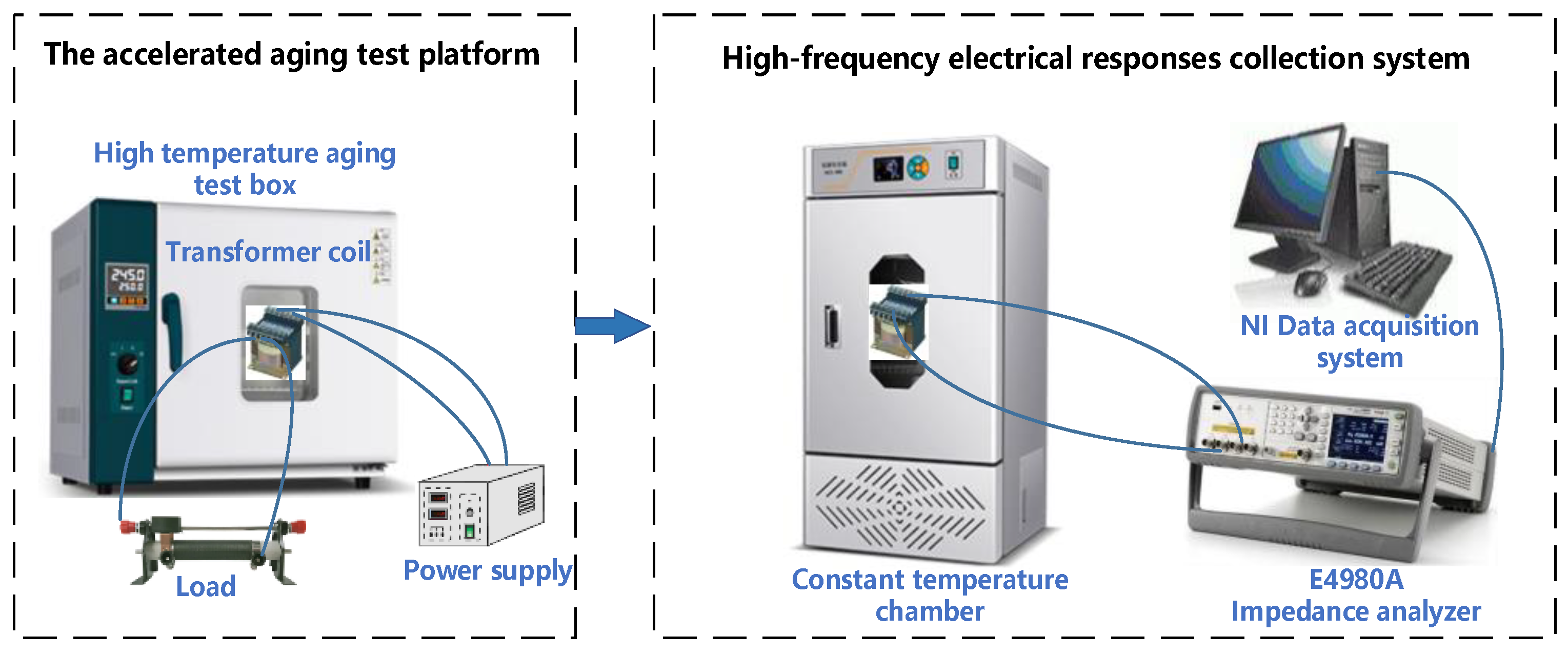

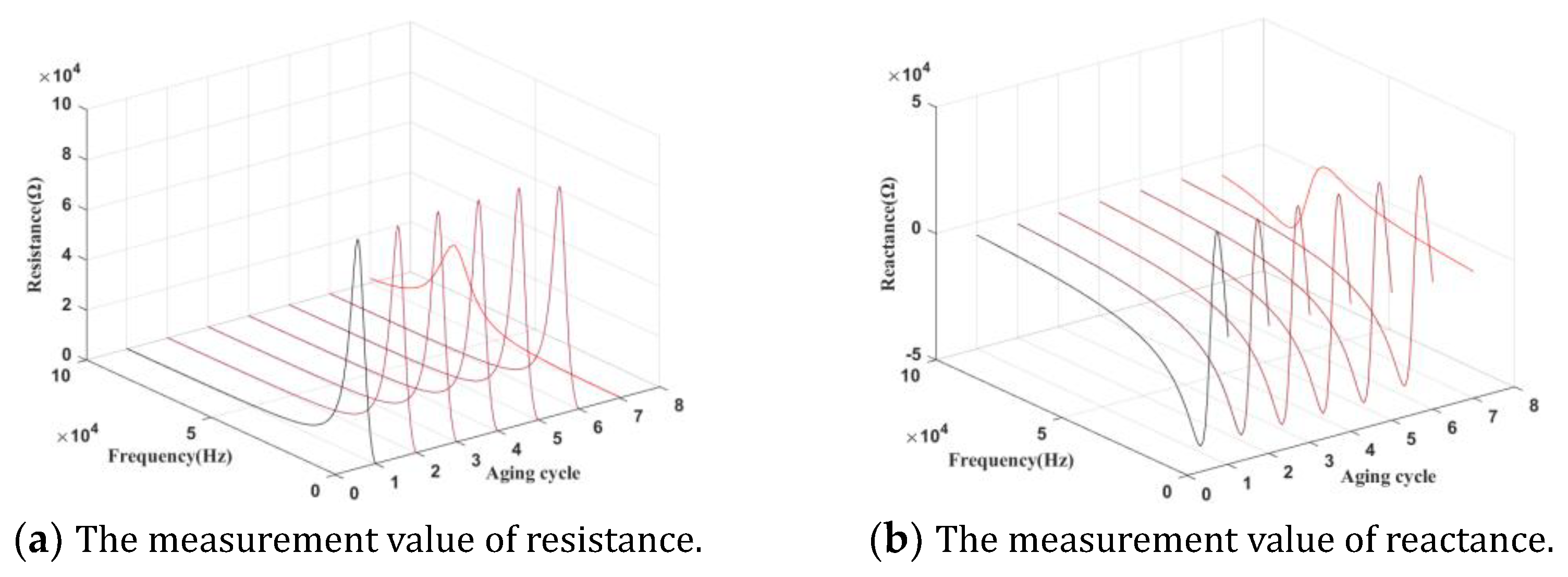
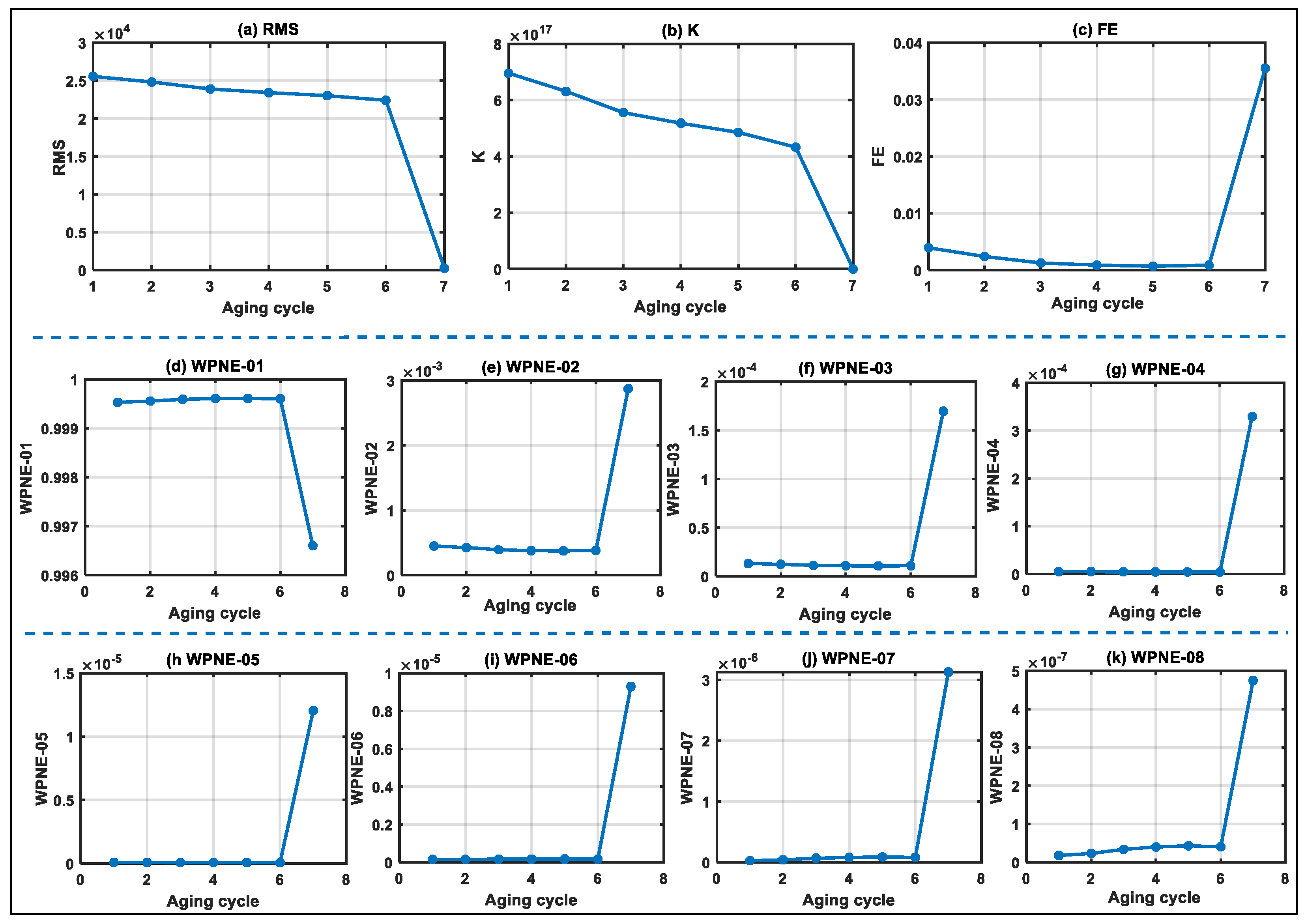

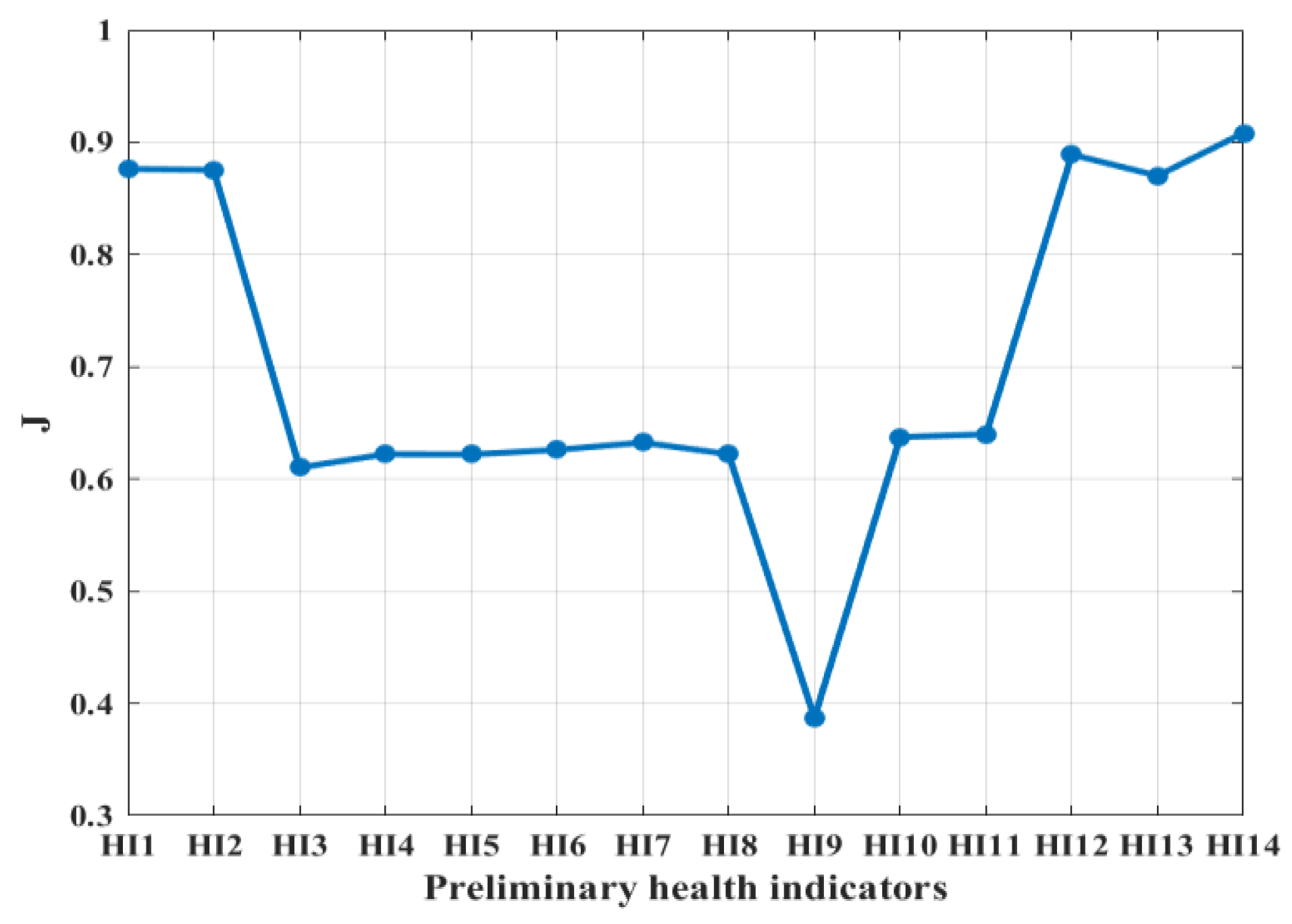
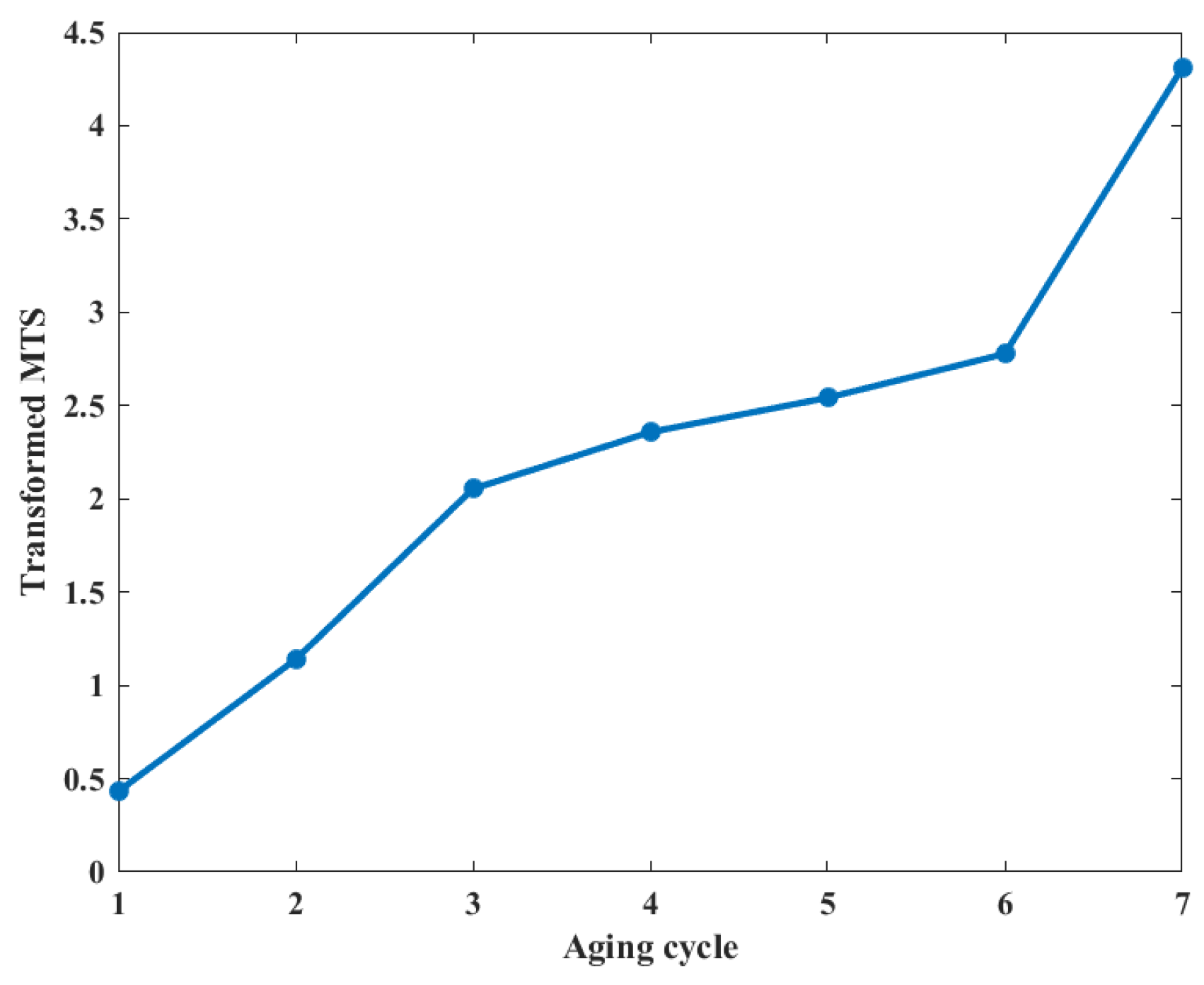
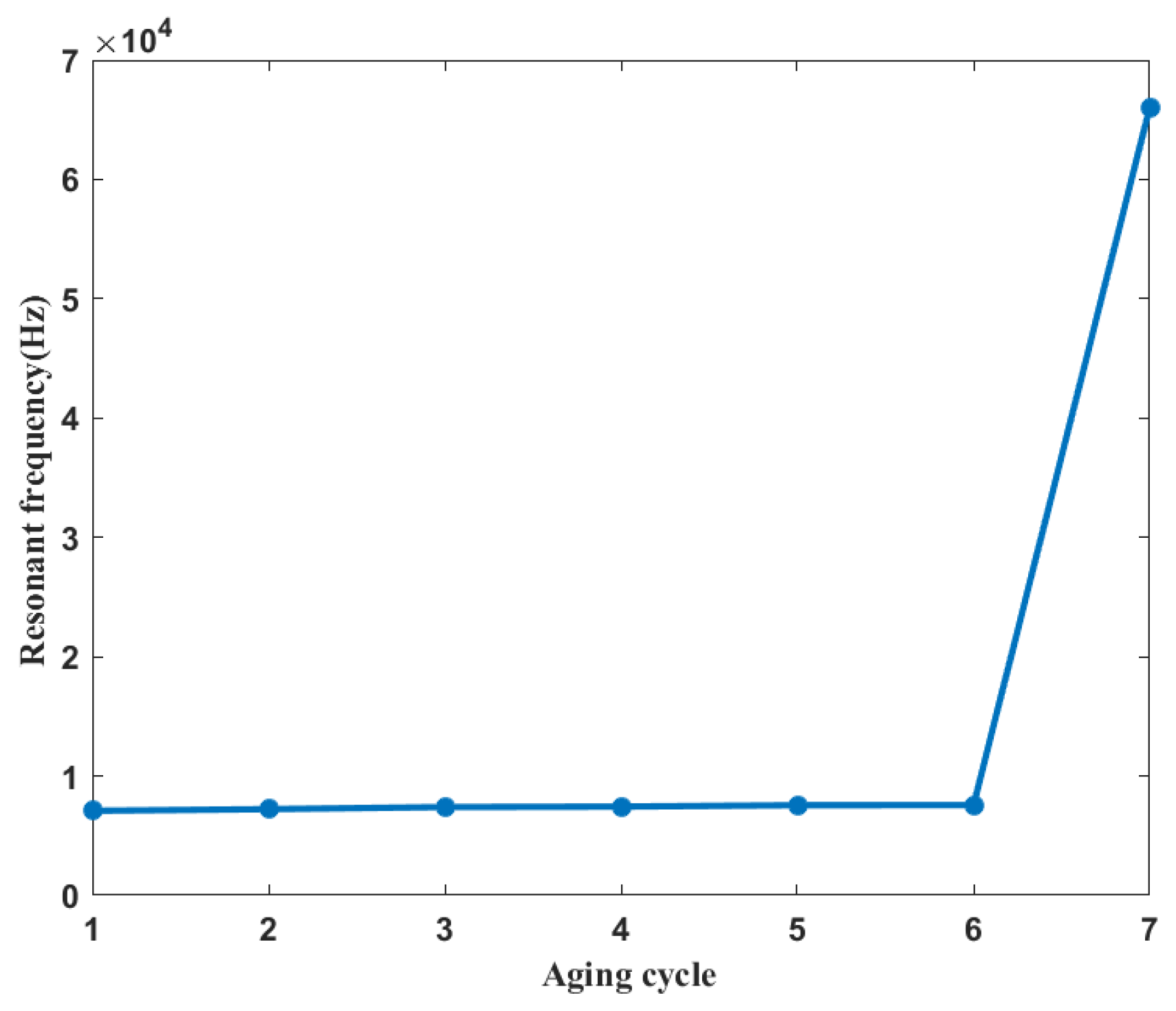


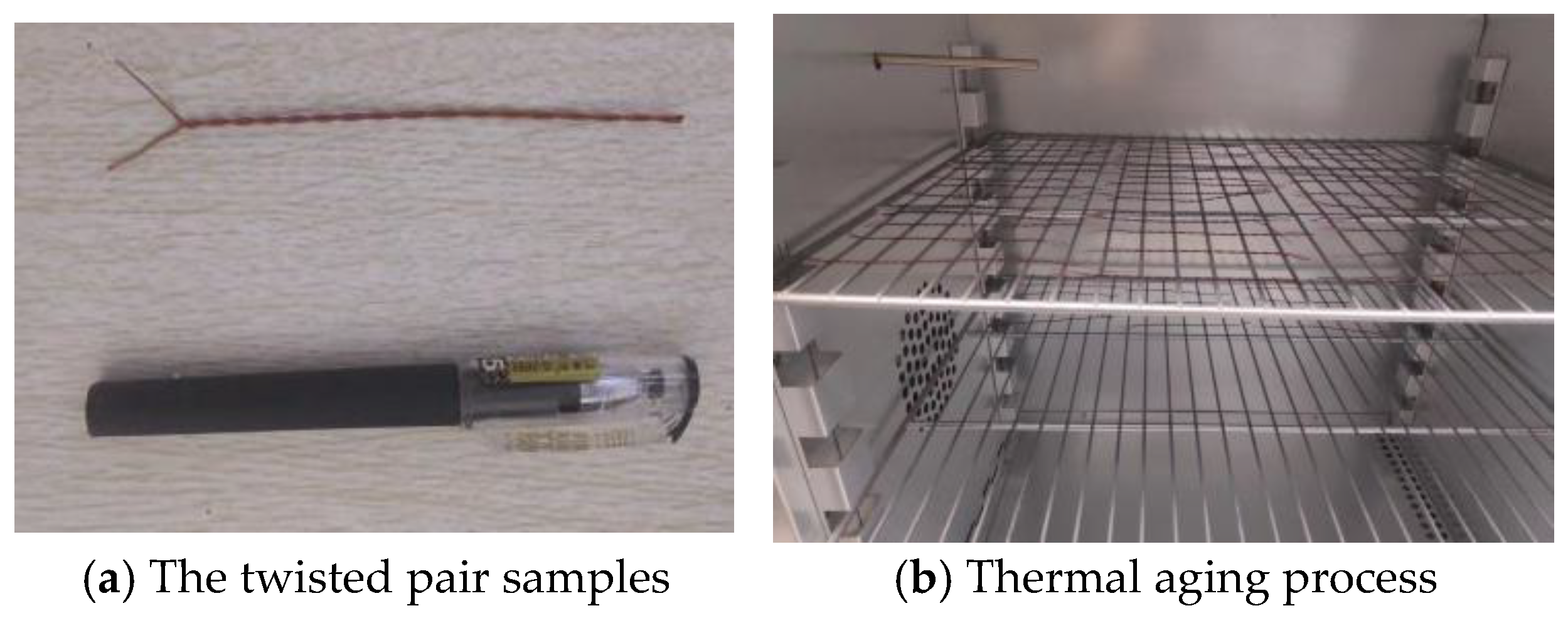
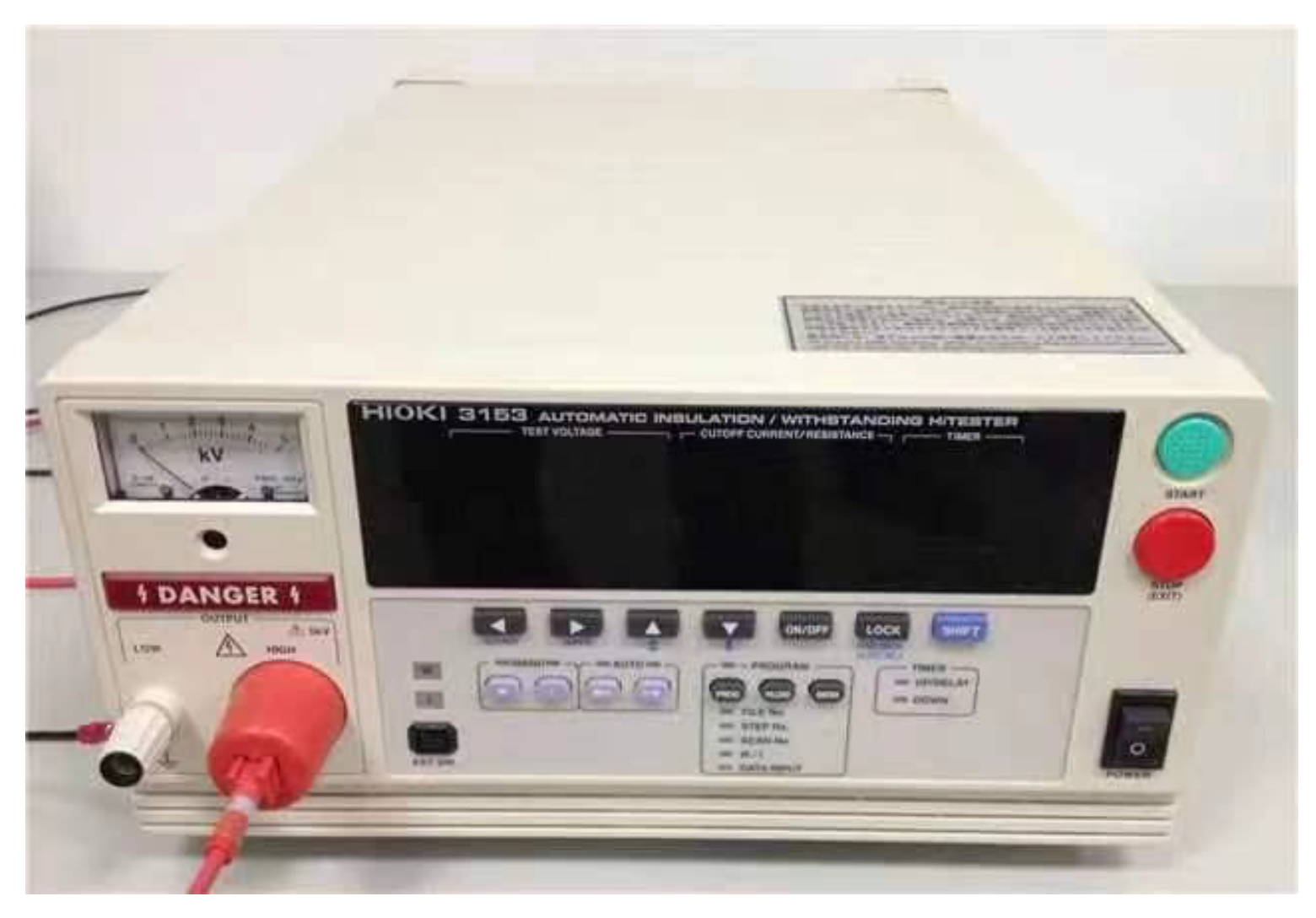
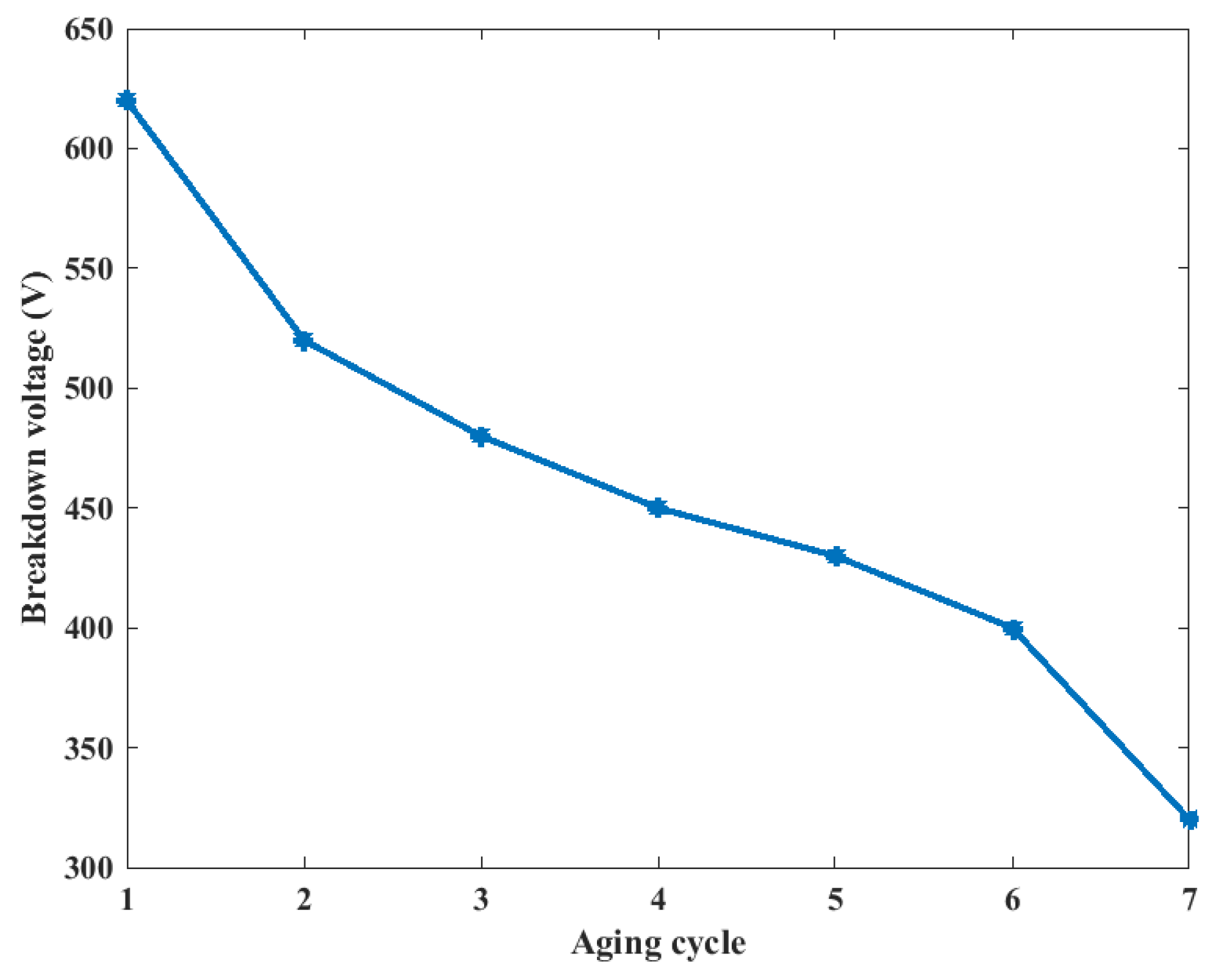

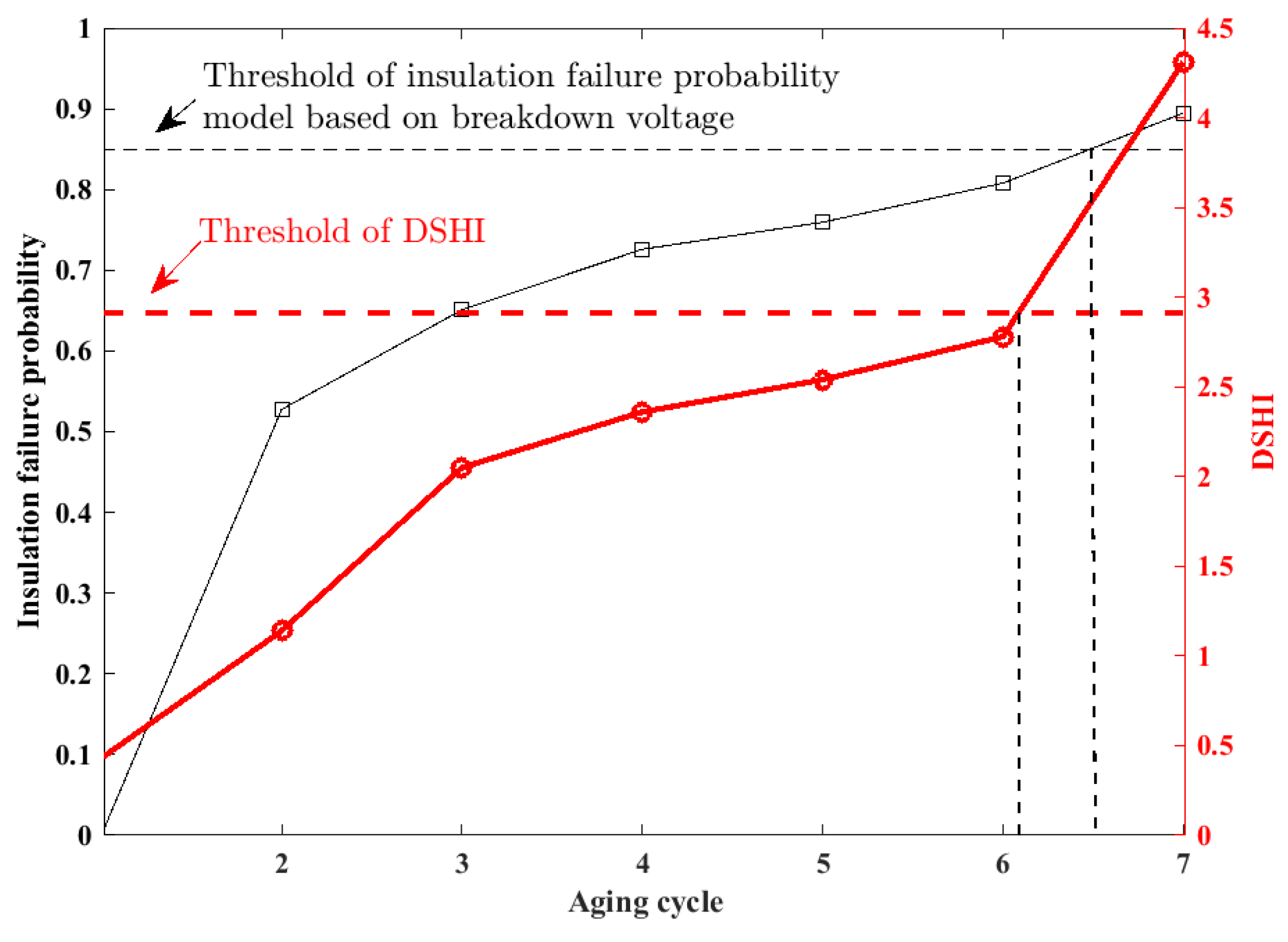
| Preliminary Health Indicators | Equation | |
|---|---|---|
| Physical health indicators | Root mean square (RMS) | |
| Kurtosis (K) | ||
| Fuzzy entropy (FE) | ||
| Wavelet packet node energy (WPNE) | ||
| Virtual health indicators | Principal component analysis (PCA) | |
| Mahalanobis-Taguchi system (MTS) | ||
| Preliminary Health Indicators | Evaluation Indexes | Symbols | |||
|---|---|---|---|---|---|
| Trend | Monotonicity | Robustness | |||
| Physical health indicators | RMS | 0.9904 | 1 | 0.3957 | HI1 |
| K | 0.9894 | 1 | 0.3930 | HI2 | |
| FE | 0.8776 | 0.6 | 0.2346 | HI3 | |
| WPNE-01 | 0.8925 | 0.6 | 0.2717 | HI4 | |
| WPNE-02 | 0.8917 | 0.6 | 0.2717 | HI5 | |
| WPNE-03 | 0.9034 | 0.6 | 0.2747 | HI6 | |
| WPNE-04 | 0.9247 | 0.6 | 0.2755 | HI7 | |
| WPNE-05 | 0.8607 | 0.6 | 0.3199 | HI8 | |
| WPNE-06 | 0.7271 | 0.2 | 0.3459 | HI9 | |
| WPNE-07 | 0.9212 | 0.6 | 0.3054 | HI10 | |
| WPNE-08 | 0.9246 | 0.6 | 0.3119 | HI11 | |
| Virtual health indicators | PCA-01 | 0.9965 | 1 | 0.4505 | HI12 |
| PCA-02 | 0.9851 | 1 | 0.3731 | HI13 | |
| MTS | 0.9775 | 1 | 0.5759 | HI14 | |
| Cycle | 1 | 2 | 3 | 4 | 5 | 6 | 7 |
|---|---|---|---|---|---|---|---|
| 0 | 52.76% | 65.01% | 72.06% | 75.95% | 80.8% | 89.46% |
Disclaimer/Publisher’s Note: The statements, opinions and data contained in all publications are solely those of the individual author(s) and contributor(s) and not of MDPI and/or the editor(s). MDPI and/or the editor(s) disclaim responsibility for any injury to people or property resulting from any ideas, methods, instructions or products referred to in the content. |
© 2023 by the authors. Licensee MDPI, Basel, Switzerland. This article is an open access article distributed under the terms and conditions of the Creative Commons Attribution (CC BY) license (https://creativecommons.org/licenses/by/4.0/).
Share and Cite
Sun, Y.; Wang, K.; Xu, A.; Guan, B.; Li, R.; Zhang, B.; Zhou, X. Degradation-Sensitive Health Indicator Construction for Precise Insulation Degradation Monitoring of Electromagnetic Coils. Entropy 2023, 25, 1354. https://doi.org/10.3390/e25091354
Sun Y, Wang K, Xu A, Guan B, Li R, Zhang B, Zhou X. Degradation-Sensitive Health Indicator Construction for Precise Insulation Degradation Monitoring of Electromagnetic Coils. Entropy. 2023; 25(9):1354. https://doi.org/10.3390/e25091354
Chicago/Turabian StyleSun, Yue, Kai Wang, Aidong Xu, Beiye Guan, Ruiqi Li, Bo Zhang, and Xiufang Zhou. 2023. "Degradation-Sensitive Health Indicator Construction for Precise Insulation Degradation Monitoring of Electromagnetic Coils" Entropy 25, no. 9: 1354. https://doi.org/10.3390/e25091354





